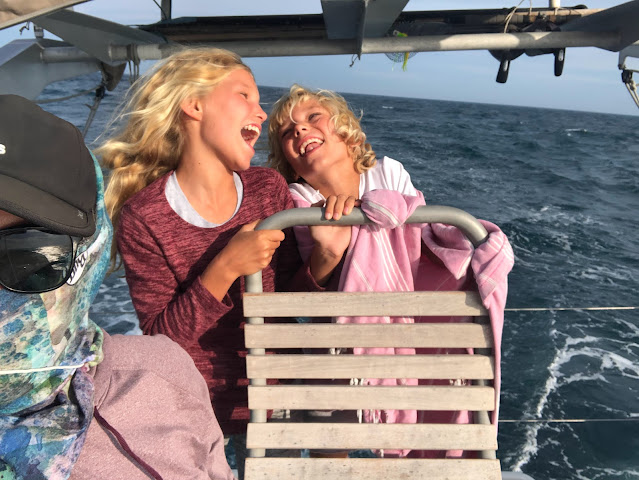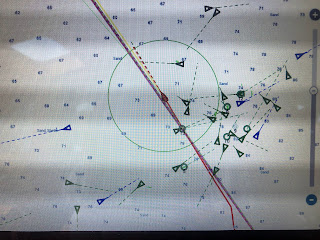Bermuda to Maine
 |
| Somewhere off the coast of New England, going a little stir-crazy. |
Cruising by a calendar
Every recreational, cruising sailor that I've met lives by the adage: don't cruise by a calendar. After staying in Bermuda for longer than planned due to Tropical Storm Alex, we transformed from cruising sailors to delivery skippers. Alex passed over Bermuda on June 7 and we needed to be in Maine by June 14. It was time to hustle.
 |
| When the wind started piping up, Hans went on deck and reefed the main. (Pulling some of the sail down to make the sail smaller and less powerful so we slow the boat down.) |
To start the summer off, we had flights scheduled out of Portland, Maine (where we're leaving the boat at a boatyard to get some projects done) on June 14. As we were sitting in Bermuda waiting out the storm, we decided that if we could get to Maine by the morning of the 13th, we could scramble and get the boat cleaned and prepped for our six week absence. If it was any time later, we'd change my plane ticket so I could stay behind and get the boat put away and then meet everyone in Florida a little later. Thankfully, we got a good forecast with plenty of wind immediately after the storm passed, so we left Bermuda on the morning of June 8 for an anticipated five day sail to Maine.
A fast, current driven sail
We had a very fast sail, party because we had good winds most of the way, but largely due to favorable currents. The Gulf Stream pushed us along at close to 11 knots for many hours, but we also encountered other random currents and eddies that kept our average well over 7 knots. I'm writing this away from the boat so I don't have the numbers we recorded in our log book, but I think we averaged over 7 knots for the entire five days. Record breaking for Positive Waves.
 |
| Out of the Gulf Stream and still squally but much calmer. |
Are we there yet?
Thankfully we all had kept our sea legs from the passage from San Juan to Bermuda so seasickness wasn't a big deal on this passage. (Except for that rough moment mid-Gulf Stream.) We were, however, all a little bored and kind of antsy. Long distance passage making is mainly a mental game. Once you get the boat on course and the sails set, the baseline of passage-making, you're basically stuck on a small boat in the middle of the ocean for days, going about the same speed as a golf cart. The sailing will entertain you for a certain amount of time and there are a number of shorts tasks from sail trimming to navigation to cooking and cleaning, but for the majority of the time it's just you and your thoughts and the horizon. Asking, or thinking, are we there yet, will only make the passage that much longer.
The Atlantic crossing was 20 days and I was very relaxed and at ease with the passage and the time. It was so long that it was pointless to think about how far we'd gone and how much further was left to go. I did a daily 24 hour log update where I tracked our mileage and average speed, but that was about the only time that I thought about our location and our progress. There was no point in wondering because the answer was always the same: there's a heck of a lot more ocean to cross.
Shorter passages are proving to be more challenging. One a five day passage, each 24 hour period brings us markedly closer to our destination. It's hard to not think about our progress when that progress is very visible on the charts. But then again, you're still only sailing about 6 knots and there is little variety in the days or the entertainment onboard. Days pass pretty slowly when there is little to do.
Joining the fishing fleet
A little more than halfway through the passage we sailed over the continental shelf of the northeast United States, as evidenced by depth (our depths suddenly went from many thousands of meters to only a couple hundred) and by the massive fleet of scallop fishermen. We had reached the Georges Bank area of the western North Atlantic Ocean. It was a little uncanny to be more or less out in the middle of the ocean and suddenly be running a slalom course of fishing boats. We listened in on some of their conversations on the VHF and it was pretty salty, to say the least. The kids definitely got an education! Think of the movie The Perfect Storm.
 |
| As we approached the continental shelf, the seas went from unruly to flat calm. |
 |
| Just a portion of the fishing boats we encountered on George's Bank. |
 |
| Of course Hans threw a line overboard when we got to the continental shelf and he was immediately rewarded. It was a quite a fight to get this tuna aboard but well worth it. |
 |
| So many tuna filets! We gave some to my mom when she met us in Portland and the rest to the crew at the boatyard. |
Being in shallow water and also within a few hundred meters of lots of other boats gave us the false impression that we were getting close, but a cursory glance at the charts showed us that we had at least 200nm to go, or at least 36 hours. If I had been at all close to achieving mid-passage zen, I immediately lost it and instead spent hours analyzing the chart and calculating when we would arrive.
 |
| The wind filled back in as we got closer to Maine and we had idyllic code zero sailing with little to no waves. |
Welcome to the United States!
Thanks to all the favorable currents, we did much better than expected and had the anchor down in Portland's outer harbor around 2:30 in the morning, over 8 hours earlier than anticipated. We got a true welcome to Maine with a downpour as we were trying to anchor, then we had to re-anchor right away because we ended up too close to a lobster pot. With the anchor down on a 4.5 day passage and wet foulies taken off, Hans and I had a celebratory hot buttered rum before we went to sleep for a few hours.
 |
| Our first anchorage in Maine. We woke up to fog that only got thicker as the morning went on. |





Comments
Post a Comment